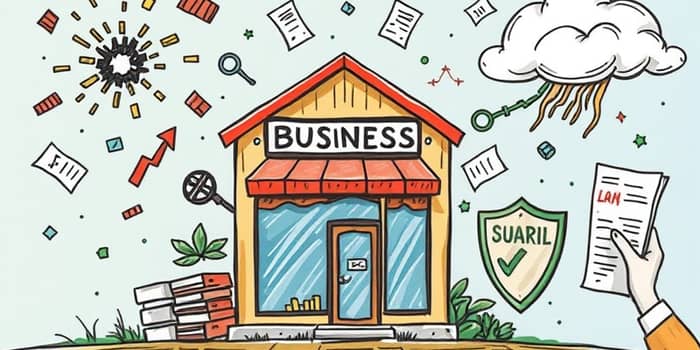Small businesses are the backbone of our economy, driving innovation and creating jobs. Yet, by the fifth anniversary, nearly fifty percent fail due to unforeseen challenges. From unexpected and crippling financial losses to reputational damage, entrepreneurs confront a myriad of threats that can derail their dreams overnight.
In this article, we'll explore the primary risks that jeopardize small enterprises and outline practical risk mitigation strategies, including the essential insurance coverages every owner should consider. By understanding and preparing for these exposures, you can safeguard your business and secure its future.
Understanding the Stakes
Small businesses face a daunting failure rate: about 50% close within five years. Common causes span from sudden and crippling cash flow shortages and legal disputes to physical harms like property damage. Additionally, data breaches and compliance failures compound vulnerabilities, especially for those lacking robust protections.
The most prevalent risks include:
- Financial instability due to cash flow shortages or unexpected expenses
- Lawsuits from customers, employees, or third parties
- Property damage from fire, theft, or natural disasters
- Data breaches and cyber incidents compromising sensitive information
- Regulatory and compliance failures leading to fines or shutdowns
Addressing each of these threats is critical to maintaining operational continuity and preserving both assets and reputation.
Cybersecurity Threats: The Invisible Danger
In 2025, small businesses were the target of 43% of all cyber attacks, yet only 14% are adequately prepared. With 87% holding customer data at risk, even a single breach can inflict severe financial and reputational harm. Human error accounts for 95% of incidents, underscoring the need for ongoing training and vigilance.
Common attack methods include:
- Malware: affecting 18% of victims, often via infected downloads
- Phishing: responsible for 17% of breaches, with some analyses attributing 57% to deceptive emails
- Ransomware: impacting 10%, particularly targeting companies with fewer than 100 employees
- Social engineering: employees face 350% more attacks than those at larger organizations
The financial toll averages $25,000 per incident but can range from $826 to $653,587. Recovery often exceeds 24 hours, halting operations and eroding customer trust—55% of consumers avoid businesses after a breach. Third-party vulnerabilities also factor in, as 59% of breaches originate from vendors.
To fortify defenses, implement robust cybersecurity defenses and protocols, conduct regular employee training, and consider comprehensive cyber liability insurance coverage to cover response and recovery costs.
Legal and Liability Exposures
Small businesses must comply with a web of laws and contractual obligations. Workers’ compensation is mandatory for firms with employees, while general liability insurance is often required by landlords or clients. Certain professions—real estate, construction, accounting, healthcare—mandate professional liability coverage to maintain licensing.
Liability risks can emanate from:
- Accidents causing bodily injury on your premises
- Property damage to a client or third party
- Product defects leading to harm or recall expenses
- Professional errors or omissions resulting in financial loss
Exposure can escalate into multi-million-dollar claims, underlining the importance of adequate and appropriate coverage limits and contractual compliance to protect both personal and business assets.
Key Insurance Solutions
Insurance stands as the cornerstone of effective risk management. Essential policies include general liability, professional liability, a business owner’s policy (BOP), cyber liability, commercial property, workers’ compensation, and umbrella insurance. Selecting the right combination hinges on your industry, operations, and client requirements.
General liability ensures legal defense and settlements, while professional liability addresses service-related claims. A BOP offers convenience and cost savings by bundling coverage. Cyber liability protects against data event expenses, and property insurance restores physical assets. Workers’ compensation is non-negotiable when you employ staff, and an umbrella policy provides extraordinary catastrophic event protection measures beyond primary limits.
Building a Resilient Business: Practical Steps
Proactive risk management combines insurance with preventive measures. Follow these five steps to enhance your business resilience:
- Conduct a comprehensive risk assessment to identify critical exposures
- Consult experienced brokers or agents for tailored coverage recommendations
- Implement regular insurance policy reviews as your business evolves
- Invest in cybersecurity hygiene, including training and multi-factor authentication
- Develop a business continuity plan to address disasters and disruptions
Beyond insurance, foster a safety culture by training staff on data handling and emergency procedures. Regular audits and penetration tests can uncover vulnerabilities before they escalate. Align your coverage with contractual and regulatory demands to avoid gaps that could leave you seriously underinsured and exposed to losses.
Ultimately, safeguarding your enterprise requires a blend of comprehensive insurance and risk mitigation. By understanding threats, securing appropriate policies, and embedding best practices into daily operations, you can reduce the likelihood of catastrophic losses and ensure long-term stability.
Don’t wait for a crisis to strike. Act now to protect your business, preserve your reputation, and maintain the trust of employees, customers, and partners. With the right strategies in place, you can face tomorrow’s challenges with confidence and focus on growth, innovation, and success.
References
- https://cake.com/empowered-team/small-business-statistics/
- https://www.allstate.com/resources/business-insurance/what-is-small-business-insurance
- https://bizplanr.ai/blog/small-business-statistics
- https://www.uschamber.com/co/run/human-resources/small-business-insurance
- https://www.bdemerson.com/article/small-business-cybersecurity-statistics
- https://www.techinsurance.com/small-business-insurance/how-much-do-i-need
- https://www.strongdm.com/blog/small-business-cyber-security-statistics
- https://www.insureon.com/small-business-insurance/general-liability/requirements










